“Who Made History? We Made History!”

Red State Revolt: The Teachers’ Strike Wave and Working-Class Politics
By Eric Blanc
(Verso, 2019) | 214 pp.
Eric Blanc’s new book is a concise compendium of insights into the United States’ biggest strike wave in decades. Its 200-plus pages comprise a must-read for education unionists looking for the path toward the collective power required to build “the schools our students deserve.”
Red State Revolt melds an overview of the mass strikes unfolding across the country’s public education landscape for the past year and a half with on-the-ground eyewitness journalism. In recounting the story of these strikes and the people who made them happen, Blanc places the movement into historical context; provides the specific details and chronologies that distinguish each state’s story (West Virginia, Oklahoma, Arizona); shows what makes them similar to and different from the others; and opens a window into some of the larger social questions at stake, such as school funding, tax policies, right-wing propaganda strategies, and neoliberal governance assumptions.
He also makes a strong case for the powerful credit owed to what he terms “the militant minority,” who through their impassioned organizing created the momentum and made key contributions at crucial moments to see these illegal strikes through to varying degrees of success. He identifies the mostly young teachers of the militant minority as democratic socialists inspired by Bernie Sanders’ 2016 primary campaign, many of whom joined Democratic Socialists of America after Trump’s election, and non-socialist educators from families with strong union roots.
Red State Revolt confirms a key lesson of labor history: that participants in successful movements against oppression generally do not win by paying overly scrupulous attention to legal systems stacked against them. As West Virginia teacher-activist Emily Comer lucidly notes, “It doesn’t matter if an action is illegal if you have enough people doing it.”
The appropriateness of that perspective becomes clear as Blanc lays out the backstory in these states, where governments captured by Republicans have driven the public education systems — along with other public services — into the dirt through years of austerity, tax cuts for the rich and corporations, rollbacks of worker rights, and relentless propaganda against the public sphere. Under such conditions the willingness of large numbers of otherwise law-abiding people to ultimately engage together in illegal acts of resistance should not surprise (although, as Blanc carefully notes, this is far from automatic).
Red State Revolt provides a welcome corrective to the generally superficial mainstream media reporting on these strikes. No, Blanc explains, these were not just spontaneous rank and file upsurges, although widespread anger at deteriorating conditions born of education funding cuts and the wrecking of personal career plans in education boiled the collective pot. No, it was not just social media created by younger teachers that, in the absence of strong unions, organized and spread the rebellion, although they certainly played an important role.
In fact, Blanc insists, the red state unions, although weaker than their counterparts in collective bargaining states, were necessary elements in building education worker power; and some of their leaders, while vacillating and mostly inexperienced in mass movement dynamics, at times played positive roles, alongside their better-known attempts to put on the brakes as the movements picked up speed.
In diving into the details of these movements, the book serves as a primer on tactics and strategies for educators to build their workplace and political power. Especially useful is the many-sided discussion of obstacles, pathways, and the hard work required to achieving the unity, within a far-flung diverse workforce, necessary to run a mass statewide strike and win.
Early in the book Blanc explains that, like many teachers, he went back to school to earn an advanced degree. The strikes broke out while he was working on his doctorate in sociology at NYU. The socialist quarterly journal Jacobin sent him to cover the action in West Virginia, Oklahoma, and Arizona.
Blanc embedded himself within each state’s movement, and due to his clear sympathies, he won the trust of activists and leaders in a way inaccessible to most mainstream media reporters, especially in an era of steep staffing decline for legacy journalism newsrooms. The words and insights of the teachers themselves — rank and file and leaders alike — leaven the narrative throughout.
And not just teachers. Blanc underscores the importance of factoring in the relationship between certificated and classified employees in determining how successful each strike was. Without the solidarity of classified staff — the mostly working-class positions in public schools like secretary, paraprofessional, groundskeeper, school bus driver, custodian, etc., as opposed to positions requiring postgraduate degrees — things might have turned out differently, for instance, in West Virginia, and he points to the failure to establish such a relationship in Oklahoma as a serious drawback limiting the gains in that state.
Another problem in Oklahoma: The fact that the state’s two most active Facebook support pages were run by teachers who weren’t union members meant serious disconnects between grassroots activists and union leadership; and decision-making around key questions and events — like what day to strike, what revenue solutions to call for — devolved to self-proclaimed leaders, rather than being submitted to the discipline of union democracy, which, as members participate, helps them to mature as activists, and the movement to debate and solidify its demands. Blanc observes that Facebook can assist in quickly scaling up a mass movement, but it can also outrun the basic organizing work necessary to ensure its success.
Running like a red thread throughout is the question of how to pay for the “schools that students deserve” (the slogan of the seminal 2012 Chicago Teachers Union strike adopted by the “Red for Ed” movements). Progressive tax policy — the principle of asking those who can best afford to pay for public services to pay the highest tax rates — is never far from the events described in Red State Revolt. Blanc properly criticizes the unclear revenue demands of union leadership in West Virginia and Oklahoma. But unlike the strong message he delivers about the crucial importance of on-the-ground organizing prior to a strike — highlighting the CTU’s prep work in Chicago as the go-to model, and citing chapter and verse in the “Red for Ed” struggles — he fails to note the equally sustained work it takes to achieve progressive tax policy.
Blanc makes no mention, for instance, of the years-long organizing it took in California before successfully passing a ballot measure to tax the rich to raise school revenues, also in 2012. He misses the obvious parallel to his own much-repeated and illustrated lesson about Chicago — that strikes don’t fall from the sky; they take serious organization over sufficient periods of time to build capacity, coalitions, and momentum — to speculate whether throwing progressive tax ideas into the mix at late stages of these strikes might have succeeded.
It’s possible that within the heated momentum of a mass public worker strike, a progressive tax demand might have a chance, simply by offering a clear answer to the question of where to find the funding. But the fate of the Hail Mary ballot measure in Arizona to up taxes on the wealthy — struck down by a reactionary state court after passage by voters — demonstrates that the best road to adequate tax revenues arises from sustained organizing for that goal.
The narrative becomes somewhat bumpy in the sprawling, 100-page chapter “The Militant Minority.” With its three detailed state chronologies and a myriad of names floating by, this section demands keen reader attention to stay with the blizzard of events and personalities. It’s held together by a robust class analysis of how mass movements function, which turns out to apply as incisively to uprisings in public education as earlier versions of this perspective did for industrial workers.
Which is not to say that Red State Revolt‘s method is mechanistic or reductionist. There is room enough in Blanc’s framework to fold in and appreciate the little moments of human creativity and solidarity that, in their accumulation, put the “rise” in an uprising, moments like when young Arizona teacher Noah Karvelis responded to red-baiting by Governor Doug Ducey, who called him a “political operative.” Said Karvelis, “The idea that I’m a political operative is absurd. I’m a K-8 music teacher — I literally spend all day singing with a puppet on my hand.” Or Blanc’s understandably proud aside describing how his mother, Lita Blanc, then-president of United Educators of San Francisco, initiated “the tradition” of pizza donations from afar to West Virginia strikers occupying the capitol (although one might argue that the author should have indicated here the background influence of the Wisconsin Uprising and Occupy Movement of 2011, which contributed, among other tactics, massive pizza donations as solidarity to demonstrators).
A close reading of Red State Revolt will be rewarded. Its flaws are minor deficiencies within a largely successful, and remarkably timely (thank you Verso Press!) effort.
In recording and theorizing this moment in education and labor history, Blanc has provided an essential gift to teacher union activists and their allies. If disseminated as widely as it deserves to be, Red State Revolt will play an invaluable role in pushing the #Red4Ed movement forward.

